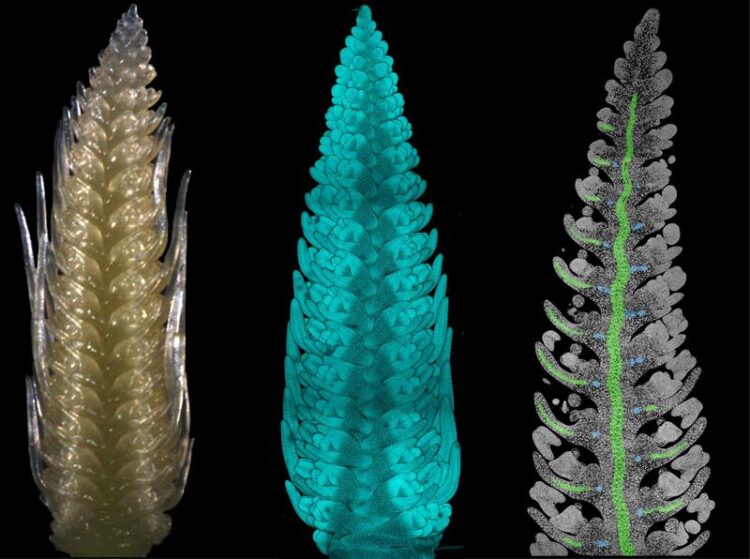How increasing the yield potential depends on the row-type in barley

The light microscope image (left) shows a lateral view. In the middle is a confocal electron micrograph. On the right, the longitudinal section through a spike shows the vascular bundles (green) and so-called transfer cells (blue).
Credit: IPK Leibniz Institute
Agriculture is the major player in contributing to global food security. Increasing our crop productivity is currently a challenging task due to the limitations of climatic change and decreasing of agricultural land. Sustainable agriculture has been considered an excellent solution for the prevailing and future environmental conditions. To contribute to sustainable agriculture by improving crop productivity, we need precise information about these crops. Knowledge about the interactions of different yield components is of great importance for the best possible exploitation of yield potential. In barley, it is particularly important to increase the number of grains per spike. However, which factors play a role in this and what differences there are between different barley row-types has hardly been researched so far.
Researchers at the IPK Leibniz Institute have therefore investigated yield components such as maximum spikelet number, spikelet fertility and final spikelet number using a group of two- and six-rowed barley types as examples. The focus was on the question of what influence the individual factors from above have on the number of spikelets. The investigation was carried out both in the greenhouse and in the field.
The results showed that grain number in two-rowed barley is largely dependent on the maximum number of spikelets, whereas the central factor in six-rowed barley is the fertility of the spikelets. “So we have to keep an eye on different trait characteristics if we want to exploit the yield potential of the individual row types as optimally as possible. This was not clear to us in this form before,” emphasised Dr. Thirulogachandar Venkatasubbu, first author of both publications and scientist of IPK’s independent research group “Plant Architecture”.
In order to estimate the maximum yield potential, it has often been assumed that the early stage of awn formation always coincides with the maximum yield potential. According to the assumption, this is true for barley irrespective of the genotype and the growth conditions. However, after their investigation of a total of 27 two- and six-rowed barley accessions, the IPK scientists are convinced that this view is no longer tenable. “The maximum yield potential does not always occur at the same developmental stage and depends on the genotype and the growth conditions,” said Dr. Thirulogachandar Venkatasubbu.
Two- and six-rowed barleys do not only differ in their respective spike architectures and how they achieve their yield potential, as it was shown in the actual study, but also in their grain composition, Prof. Dr. Schnurbusch, head of the independent research group “Plant Architecture” and HEISENBERG professor at the IPK and the Martin Luther University Halle-Wittenberg, pointed out.
Although both barley forms can be crossed with each other, they are treated almost like separate genetic pools by plant breeders because of their very different directions of use. Two-rowed barley is usually cultivated as a summer form, predominantly in southern Germany. “Because of its low protein content, this barley is mostly used for brewing,” explained Prof. Dr. Thorsten Schnurbusch. The six-rowed barley is usually grown as a winter form. With a high protein content, they are very suitable as animal feed.
The two current publications are the first of the IPK’s indepenendet research group “Plant Architecture” to be produced in the course of funding by a “Consolidator Grant” from the European Research Council. “We will genetically analyse these now discovered differences in barley in further studies and resolve these observations in detail at the molecular level”, emphasized Prof. Dr. Thorsten Schnurbusch.
Journal: Journal of Experimental Botany
DOI: 10.1093/jxb/erab395
Method of Research: Experimental study
Subject of Research: Not applicable
Article Title: Strategies of grain number determination differentiate barley row types
Media Contacts
Christian Schafmeister
Leibniz Institute of Plant Genetics and Crop Plant Research
christian.schafmeister@ipk-gatersleben.de
Office: 0049-394-825-461
Prof. Dr. Thorsten Schnurbusch
IPK Leibniz Institute
schnurbusch@ipk-gatersleben.de
Office: +49394825341
www.ipk-gatersleben.de
Media Contact
All latest news from the category: Life Sciences and Chemistry
Articles and reports from the Life Sciences and chemistry area deal with applied and basic research into modern biology, chemistry and human medicine.
Valuable information can be found on a range of life sciences fields including bacteriology, biochemistry, bionics, bioinformatics, biophysics, biotechnology, genetics, geobotany, human biology, marine biology, microbiology, molecular biology, cellular biology, zoology, bioinorganic chemistry, microchemistry and environmental chemistry.
Newest articles

A universal framework for spatial biology
SpatialData is a freely accessible tool to unify and integrate data from different omics technologies accounting for spatial information, which can provide holistic insights into health and disease. Biological processes…

How complex biological processes arise
A $20 million grant from the U.S. National Science Foundation (NSF) will support the establishment and operation of the National Synthesis Center for Emergence in the Molecular and Cellular Sciences (NCEMS) at…

Airborne single-photon lidar system achieves high-resolution 3D imaging
Compact, low-power system opens doors for photon-efficient drone and satellite-based environmental monitoring and mapping. Researchers have developed a compact and lightweight single-photon airborne lidar system that can acquire high-resolution 3D…





















